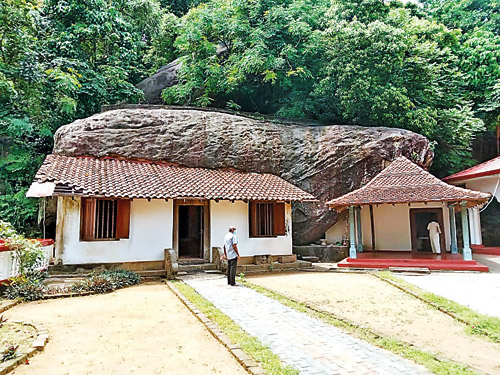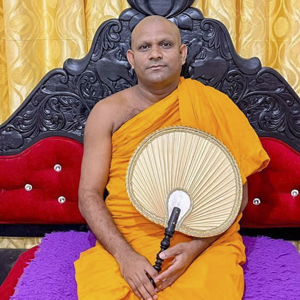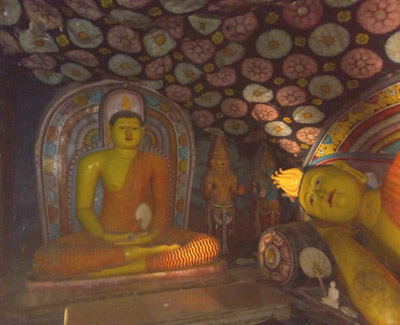The importance of Esala Poya; in conversation with the Viharadhikari of the Raja Maha Viharaya, Kurunegala

The small drip-ledge cave
For Buddhists, Esala Full Moon Poya is as important as Vesak and Poson Poya. Prince Siddhartha Gautama renounced his lay life to live as an ascetic in search of what he said was, “the true meaning of life.” On that same day, Esala Poya, his son Prince Rahula, was born to Princess Yasodhara. After the Buddha’s Supreme Enlightenment, he preached the first Buddha Dhamma on an Esala Poya to the five ascetics with whom he lived before he went on his own. He visited the Tavatimsa Divyalokaya (Tavatimsa Heaven) to preach the Abhidhamma. The yamakamaha prathiharya (twin miracles) were performed to shatter the pride of his Sakyan kinsmen. On an Esala Poya, Buddha requested the bhikkhus to spend the vas season (rainy season) indoors and avoid travel.
In Sri Lanka, many important events took place on an Esala Poya. King Dutugemunu laid the foundation for the Ruwanweli mahaseya in Anuradhapura. The upasampada (high ordination) was revived by Ven. Maha Thera Upali of Siam in the Malwatte temple. At present, the Malwatte and Asgiriya temples take turns for the Theva (duty) at the Sri Dalada Maligawa on the day after Esala Poya.

Viharadhikari Ven. Weerapokuné Sumangala Thera
The Sunday Times spoke to Ven. Weerapokuné Sumangala Thera, the Viharadhikari (incumbent monk) of the Athkadha or Haththikanda Raja Maha Viharaya in Kurunegala City that belongs to the Asgiriya Chapter, and the Thera explained its long history. He said, “the Viharadhipathi of the temple is the Anunayaka of the Asgiriya Chapter, Most Ven. Anamaduwé Dhammadassi Thera.” The viharaya (temple) is at the foot of the massive Athugala rock. It is a rock cave temple with two drip-ledge caves adjacent to each other. The larger one has the reclining Buddha image, and the other has many more images. Both have beautiful paintings on the inner top surface. The Bodhi tree is believed to have been brought from Anuradhapura. There is no clear record of the history of the temple, although it’s a very ancient temple. Under the patronage of King Parakramabahu IV of Dambadeniya, the temple was improved.
At present, there are six resident monks. They will observe the Vas season in the temple from the day after Esala Poya. During the Anuradhapura period, this was a monastery where monks from the Mahavihara broke journey before proceeding to the Asgiriya Temple Monastery in Senkadagalapura.”
The Thera explained about the annual Sri Dalada Poson Perahera, which was held on July 5, in the month of Esala. When asked about the word Poson, which is in June, he said “thavama Poson (it is still poson).”

The Buddha statues in the inner cave
“This is the 99th perahera, and next year we will have a special programme to commemorate the 100th perahera. The perahera was initiated by King Parakramabahu IV of Dambadeniya, but due to foreign invasions and wars, it was not a regular event. An important feature of this perahera is the display of the Pansiya Panas Jataka stories (550 Jataka stories) placed on a caparisoned elephant and paraded through the streets.” Explaining about the Jataka stories, the Thera said, “The Pali version was translated to Sinhala by a monk who lived in this temple during the time of King Parakramabahu IV.”
A stone inscription was shown saying it is an engraving of the monk writing the Jataka stories, but it cannot be seen clearly. The Jataka stories instructed people on moral behaviour and moral consciousness. The writer had the opportunity to view this valuable work of the translated Jataka stories, which is under lock and key for protection.
According to folklore, King Parakramabahu IV saw a beautiful Muslim woman and made her a yakada doli consort. A son was born to her and was named Vathimi Bandara, but a fraction of the people plotted against him to prevent him from ascending the throne, and he was killed when he was pushed down the massive rock. The first queen did not have any children. However, there are many versions to this story, with Muslims saying that the woman was the wife of an Arab trader who came with her son in search of him.
However, there is a devale built at the Viharaya premises where Sinhalese people worship, as they believe Vathimi Bandara is a reincarnation of Galé Bandara Deiyo (the deity of the rock), and the devale is built where he fell to his death. The Muslims have another burial place a little further from the temple, and they believe the prince was buried there. The legend of Vathimi Bandara is steeped in mystery and intrigue.
Searching for an ideal partner? Find your soul mate on Hitad.lk, Sri Lanka's favourite marriage proposals page. With Hitad.lk matrimonial advertisements you have access to thousands of ads from potential suitors who are looking for someone just like you.


